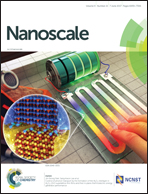Nonlinear photoluminescence in monolayer WS2: parabolic emission and excitation fluence-dependent recombination dynamics†
Abstract
Recombination dynamics during photoluminescence (PL) in two-dimensional (2D) semiconducting transition metal dichalcogenides (TMDs) are complicated and can be easily affected by the surroundings because of their atomically thin structures. Herein, we studied the excitation power and temperature dependence of the recombination dynamics on the chemical vapor deposition-grown monolayer WS2via a combination of Raman, PL, and time-resolved PL spectroscopies. We found a red shift and parabolic intensity increase in the PL emission of the monolayer WS2 with the increasing excitation power and the decay time constants corresponding to the recombination of trions and excitons from transient PL dynamics. We attributed the abovementioned nonlinear changes in the PL peak positions and intensities to the combination of increasing carrier interaction and band structure renormalization rather than to the thermal effect from a laser. Furthermore, the excitation power-dependent Raman measurements support our conclusion. These findings and understanding will provide important information for the development of TMD-based optoelectronics and photonics.



 Please wait while we load your content...
Please wait while we load your content...